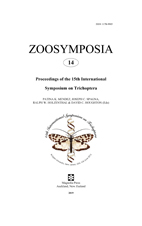Abstract
A four-season survey of Trichoptera between April 2008 and January 2009, from 20 sites in 11 rivers flowing off the Tsitsikamma mountains in the Eastern and Western Cape, collected 42,683 adults and 6741 larvae, comprising 48 species in 22 genera and 12 families. Trichoptera were the numerically dominant freshwater macroinvertebrate taxon. Of the species collected, 15 are recognised regional Cape Floristic Realm (CFR) endemics. Some specimens of Trichoptera that could not be recognised as described species are now the subject of further studies. Distinct differences between rivers, in terms of species composition of Trichoptera, were noted. The variation in species composition can be partially explained by the physicochemical and ecological attributes of the rivers surveyed. Anthropogenic disturbances were noted in most of the lower reaches of the rivers. The upper reaches of the rivers could be statistically grouped together and thus be considered as a unit for conservation. The highest diversity, 25 species, was recorded from the pristine upper reaches of the Bobbejaans River. An evaluation of conservation requirements identified a number of threats: increased loads of fine sediment and nutrients, higher water temperature regimes, and changes to pH, from the natural acid (pH < 5.5) to neutral or alkaline conditions. Changes in any of these would be detrimental to the survival of many of the endemic Trichoptera in the CFR, and all of these changes would be exacerbated by decreased water-flow volumes. It is thus important to limit the levels of water abstraction from these rivers: to ensure the maintenance of cool temperature and acidic pH regimes while limiting nutrient levels in the rivers. To maintain conservation of the lower reaches of the rivers it is recommended that an ecologically-functional continuity with upstream reaches is maintained to enable the occupation of all zones of the rivers with a diversity of CFR freshwater endemic species. Some CFR Trichoptera were selected as indicators of favourable conditions for the survival and maintenance of viable populations of other CFR-endemic freshwater species.

